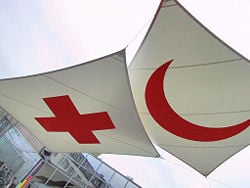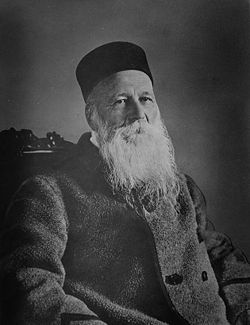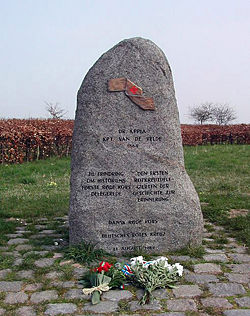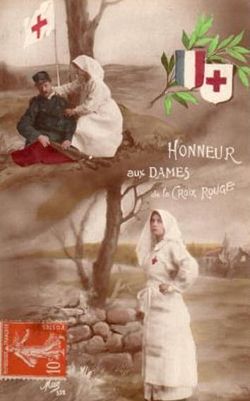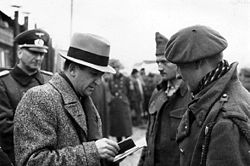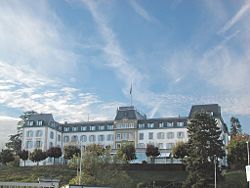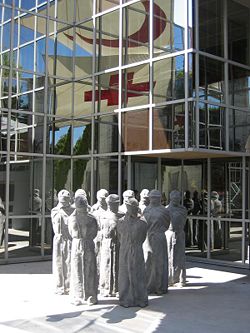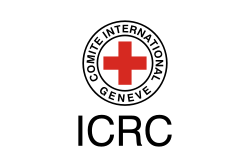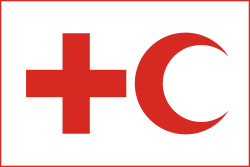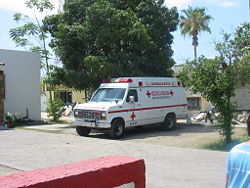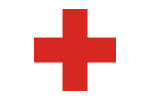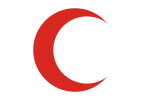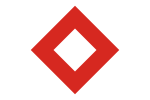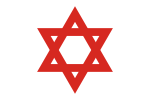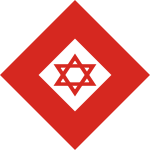Red Cross
The International Red Cross and Red Crescent Movement French: Mouvement international de la Croix-Rouge et du Croissant-Rouge, is an international humanitarian movement with approximately 97 million volunteers worldwide whose stated mission is to protect human life and health, to ensure respect for the human being, and to prevent and alleviate human suffering, without any discrimination based on nationality, race, religious beliefs, class, or political opinions. The often-heard term "International Red Cross" is actually a misnomer, as no official organization as such exists bearing that name. In reality, the movement consists of several distinct organizations that are legally independent from each other, but are united within the Movement through common basic principles, objectives, symbols, statutes, and governing organs. The Red Cross and Red Crescent societies are perhaps the most voluntary successful humanitarian movement in history. They play a unique role in monitoring the implementation of international law regarding the conduct of war, including the treatment of prisoners. In the latter area, the movement has a unique legal right to visit any person being held as a prisoner of war. Around the globe, millions of people contribute time and their skills to assist in the movement's work, such as rendering first-aid and in voluntary ambulance crews. The value of this civil society initiative's contribution to humanitarian work is incalculable, and the movement is an outstanding example of how non-state actors can make a material difference to the quality of human life, and to creating peace between nations and peoples. Its Emergency Response Units are often the first to reach a scene, and to render humanitarian aid whether nationally or internationally.
For example, after the Boxing Day tsunami, 2004 Red Cross workers were immediately involved in aid, medical and relief work. Arguably, the Red Cross has itself contributed towards the development of human consciousness of a world society in which all people have mutual obligations and responsibilities, in which universally valid values and rights are shared by all people. Controversy has sometimes surrounded the Red Cross' interpretation of the Geneva Conventions, such as their applicability on the West Bank of the Jordan. Some point out that national leaders, who are often First Ladies, do not active contribute to the agency's work, although voluntary agencies often have celebrities' names on their letterheads who do little more than attend an occasional meeting while the real work is carried out by paid staff, or in many instances by less well known volunteers.
Organization
The Movement consists of:
- The International Committee of the Red Cross (ICRC) is a private humanitarian institution founded in 1863 in Geneva, Switzerland. Its 25-member committee has a unique authority under international humanitarian law to protect the life and dignity of the victims of international and internal armed conflicts.
- The International Federation of Red Cross and Red Crescent Societies (IFRC) was founded in 1919 and today it coordinates activities between the 186 National Red Cross and Red Crescent Societies within the Movement. On an international level, the Federation leads and organizes, in close cooperation with the National Societies, relief assistance missions responding to large-scale emergencies. The International Federation Secretariat is based in Geneva, Switzerland.
- National Red Cross and Red Crescent Societies exist in nearly every country in the world. Currently 186 National Societies are recognized by the ICRC and admitted as full members of the Federation. Each entity works in its home country according to the principles of international humanitarian law and the statutes of the international Movement. Depending on their specific circumstances and capacities, National Societies can take on additional humanitarian tasks that are not directly defined by international humanitarian law or the mandates of the international Movement.
History of the movement
The International Committee of the Red Cross
Solferino, Henry Dunant, and the foundation of the ICRC
Up until the middle of the 19th century, there were no organized and well-established army nursing systems for casualties and no safe and protected institutions to accommodate and treat those who were wounded on the battlefield. In June 1859, the Swiss businessman Henry Dunant traveled to Italy to meet French emperor Napoléon III with the intention of discussing difficulties in conducting business in Algeria, at that time occupied by France. When he arrived in the small town of Solferino on the evening of June 24, he witnessed the Battle of Solferino, an engagement in the Austro-Sardinian War. In a single day, about 40,000 soldiers on both sides died or were left wounded on the field. Henry Dunant was shocked by the terrible aftermath of the battle, the suffering of the wounded soldiers, and the near-total lack of medical attendance and basic care. He completely abandoned the original intent of his trip and for several days he devoted himself to helping with the treatment and care for the wounded. He succeeded in organizing an overwhelming level of relief assistance by motivating the local population to aid without discrimination. Back in his home in Geneva, he decided to write a book, entitled A Memory of Solferino, which he published with his own money in 1862. He sent copies of the book to leading political and military figures throughout Europe. In addition to penning a vivid description of his experiences in Solferino in 1859, he explicitly advocated the formation of national voluntary relief organizations to help nurse wounded soldiers in the case of war. In addition, he called for the development of international treaties to guarantee the neutrality and protection of those wounded on the battlefield as well as medics and field hospitals.
On February 9, 1863, in Geneva, Henry Dunant founded the "Committee of the Five" (together with four other leading figures from well-known Geneva families) as an investigatory commission of the Geneva Society for Public Welfare. Their aim was to examine the feasibility of Dunant's ideas and to organize an international conference about their possible implementation. The members of this committee, aside from Dunant himself, were Gustave Moynier, lawyer and chairman of the Geneva Society for Public Welfare; physician Louis Appia, who had significant experience working as a field surgeon; Appia's friend and colleague Théodore Maunoir, from the Geneva Hygiene and Health Commission; and Guillaume-Henri Dufour, a Swiss Army general of great renown. Eight days later, the five men decided to rename the committee to the "International Committee for Relief to the Wounded." In October (26-29) 1863, the international conference organized by the committee was held in Geneva to develop possible measures to improve medical services on the battle field. The conference was attended by 36 individuals: Eighteen official delegates from national governments, six delegates from other non-governmental organizations, seven non-official foreign delegates, and the five members of the International Committee. The states and kingdoms represented by official delegates were Baden, Bavaria, France, the United Kingdom of Great Britain and Ireland, Hanover, Hesse, Italy, the Netherlands, Austria, Prussia, Russia, Saxony, Sweden, and Spain. Among the proposals written in the final resolutions of the conference, adopted on October 29, 1863, were:
- The foundation of national relief societies for wounded soldiers
- Neutrality and protection for wounded soldiers
- The utilization of volunteer forces for relief assistance on the battlefield
- The organization of additional conferences to enact these concepts in legally binding international treaties
- The introduction of a common distinctive protection symbol for medical personnel in the field, namely a white armlet bearing a red cross
Only one year later, the Swiss government invited the governments of all European countries, as well as the United States, Brazil, and Mexico, to attend an official diplomatic conference. Sixteen countries sent a total of twenty-six delegates to Geneva. On August 22, 1864, the conference adopted the first Geneva Convention "for the Amelioration of the Condition of the Wounded in Armies in the Field." Representatives of 12 states and kingdoms signed the convention: Baden, Belgium, Denmark, France, Hesse, Italy, the Netherlands, Portugal, Prussia, Switzerland, Spain, and Württemberg. The convention contained ten articles, establishing for the first time legally binding rules guaranteeing neutrality and protection for wounded soldiers, field medical personnel, and specific humanitarian institutions in an armed conflict. Furthermore, the convention defined two specific requirements for recognition of a national relief society by the International Committee:
- The national society must be recognized by its own national government as a relief society according to the convention, and
- The national government of the respective country must be a state party to the Geneva Convention.
Directly following the establishment of the Geneva Convention, the first national societies were founded in Belgium, Denmark, France, Oldenburg, Prussia, Spain, and Württemberg. Also in 1864, Louis Appia and Charles van de Velde, a captain of the Dutch Army, became the first independent and neutral delegates to work under the symbol of the Red Cross in an armed conflict. Three years later in 1867, the first International Conference of National Aid Societies for the Nursing of the War Wounded was convened.
Also in 1867, Henry Dunant was forced to declare bankruptcy due to business failures in Algeria, partly because he had neglected his business interests during his tireless activities for the International Committee. Controversy surrounding Dunant's business dealings and the resulting negative public opinion, combined with an ongoing conflict with Gustave Moynier, led to Dunant's expulsion from his position as a member and secretary. He was charged with fraudulent bankruptcy and a warrant for his arrest was issued. Thus, he was forced to leave Geneva and never returned to his home city. In the following years, national societies were founded in nearly every country in Europe. In 1876, the committee adopted the name "International Committee of the Red Cross" (ICRC), which is still its official designation today. Five years later, the American Red Cross was founded through the efforts of Clara Barton. More and more countries signed the Geneva Convention and began to respect it in practice during armed conflicts. In a rather short period of time, the Red Cross gained huge momentum as an internationally respected movement, and the national societies became increasingly popular as a venue for volunteer work.
When the first Nobel Peace Prize was awarded in 1901, the Norwegian Nobel Committee opted to give it jointly to Henry Dunant and Frédéric Passy, a leading international pacifist. More significant than the honor of the prize itself, the official congratulation from the International Committee of the Red Cross marked the overdue rehabilitation of Henry Dunant and represented a tribute to his key role in the formation of the Red Cross. Dunant died nine years later in the small Swiss health resort of Heiden. Only two months earlier his long-standing adversary Gustave Moynier had also died, leaving a mark in the history of the Committee as its longest-serving president ever.
In 1906, the 1864 Geneva Convention was revised for the first time. One year later, the Hague Convention X, adopted at the Second International Peace Conference in The Hague, extended the scope of the Geneva Convention to naval warfare. Shortly before the beginning of the First World War in 1914, 50 years after the foundation of the ICRC and the adoption of the first Geneva Convention, there were already 45 national relief societies throughout the world. The movement had extended itself beyond Europe and North America to Central and South America (Argentina, Brazil, Chile, Cuba, Mexico, Peru, El Salvador, Uruguay, Venezuela), Asia (the Republic of China, Japan, Korea, Siam), and Africa (Republic of South Africa).
The ICRC during World War I
With the outbreak of World War I, the ICRC found itself confronted with enormous challenges which it could only handle by working closely with the national Red Cross societies. Red Cross nurses from around the world, including the United States and Japan, came to support the medical services of the armed forces of the European countries involved in the war. On October 15, 1914, immediately after the start of the war, the ICRC set up its International Prisoners-of-War (POW) Agency, which had about 1,200 mostly volunteer staff members by the end of 1914. By the end of the war, the Agency had transferred about 20 million letters and messages, 1.9 million parcels, and about 18 million Swiss francs in monetary donations to POWs of all affected countries. Furthermore, due to the intervention of the Agency, about 200,000 prisoners were exchanged between the warring parties, released from captivity and returned to their home country. The organizational card index of the Agency accumulated about 7 million records from 1914 to 1923, each card representing an individual prisoner or missing person. The card index led to the identification of about 2 million POWs and the ability to contact their families. The complete index is on loan today from the ICRC to the International Red Cross and Red Crescent Museum in Geneva. The right to access the index is still strictly restricted to the ICRC.
During the entire war, the ICRC monitored warring partiesâ compliance with the Geneva Conventions of the 1907 revision and forwarded complaints about violations to the respective country. When chemical weapons were used in this war for the first time in history, the ICRC vigorously protested against this new type of warfare. Even without having a mandate from the Geneva Conventions, the ICRC tried to ameliorate the suffering of civil populations. In territories that were officially designated as "occupied territories," the ICRC could assist the civilian population on the basis of the Hague Convention's "Laws and Customs of War on Land" of 1907. This convention was also the legal basis for the ICRC's work for prisoners of war. In addition to the work of the International Prisoner-of-War Agency as described above, this included inspection visits to POW camps. A total of 524 camps throughout Europe were visited by 41 delegates from the ICRC until the end of the war.
Between 1916 and 1918, the ICRC published a number of postcards with scenes from the POW camps. The pictures showed the prisoners in day-to-day activities such as the distribution of letters from home. The intention of the ICRC was to provide the families of the prisoners with some hope and solace and to alleviate their uncertainties about the fate of their loved ones. After the end of the war, the ICRC organized the return of about 420,000 prisoners to their home countries. In 1920, the task of repatriation was handed over to the newly founded League of Nations, which appointed the Norwegian diplomat and scientist Fridtjof Nansen as its "High Commissioner for Repatriation of the War Prisoners." His legal mandate was later extended to support and care for war refugees and displaced persons when his office became that of the League of Nations "High Commissioner for Refugees." Nansen, who invented the Nansen passport for stateless refugees and was awarded the Nobel Peace Prize in 1922, appointed two delegates from the ICRC as his deputies.
A year before the end of the war, the ICRC received the 1917 Nobel Peace Prize for its outstanding wartime work. It was the only Nobel Peace Prize awarded in the period from 1914 to 1918. In 1923, the Committee adopted a change in its policy regarding the selection of new members. Until then, only citizens from the city of Geneva could serve in the Committee. This limitation was expanded to include Swiss citizens. As a direct consequence of World War I, an additional protocol to the Geneva Convention was adopted in 1925 which outlawed the use of suffocating or poisonous gases and biological agents as weapons. Four years later, the original Convention was revised and the second Geneva Convention "relative to the Treatment of Prisoners of War" was established. The events of World War I and the respective activities of the ICRC significantly increased the reputation and authority of the Committee among the international community and led to an extension of its competencies.
As early as in 1934, a draft proposal for an additional convention for the protection of the civil population during an armed conflict was adopted by the International Red Cross Conference. Unfortunately, most governments had little interest in implementing this convention, and it was thus prevented from entering into force before the beginning of World War II.
The ICRC and World War II

The legal basis of the work of the ICRC during World War II were the Geneva Conventions in their 1929 revision. The activities of the Committee were similar to those during World War I: Visiting and monitoring POW camps, organizing relief assistance for civilian populations, and administering the exchange of messages regarding prisoners and missing persons. By the end of the war, 179 delegates had conducted 12,750 visits to POW camps in 41 countries. The Central Information Agency on Prisoners-of-War (Zentralauskunftsstelle für Kriegsgefangene) had a staff of 3,000, the card index tracking prisoners contained 45 million cards, and 120 million messages were exchanged by the Agency. One major obstacle was that the Nazi-controlled German Red Cross refused to cooperate with the Geneva statutes including blatant violations such as the deportation of Jews from Germany and the mass murders conducted in the concentration camps run by the German government. Moreover, two other main parties to the conflict, the Soviet Union and Japan, were not party to the 1929 Geneva Conventions and were not legally required to follow the rules of the conventions.
During the war, the ICRC failed to obtain an agreement with Nazi Germany about the treatment of detainees in concentration camps, and it eventually abandoned applying pressure in order to avoid disrupting its work with POWs. The ICRC also failed to develop a response to reliable information about the extermination camps and the mass killing of European Jews. This is still considered the greatest failure of the ICRC in its history. After November 1943, the ICRC achieved permission to send parcels to concentration camp detainees with known names and locations. Because the notices of receipt for these parcels were often signed by other inmates, the ICRC managed to register the identities of about 105,000 detainees in the concentration camps and delivered about 1.1 million parcels, primarily to the camps Dachau, Buchenwald, Ravensbrück, and Sachsenhausen.
On March 12, 1945, ICRC president Jacob Burckhardt received a message from SS General Ernst Kaltenbrunner accepting the ICRC's demand to allow delegates to visit the concentration camps. This agreement was bound by the condition that these delegates would have to stay in the camps until the end of the war. Ten delegates, among them Louis Haefliger (Camp Mauthausen), Paul Dunant (Camp Theresienstadt), and Victor Maurer (Camp Dachau), accepted the assignment and visited the camps. Louis Haefliger prevented the forceful eviction or blasting of Mauthausen-Gusen by alerting American troops, thereby saving the lives of about 60,000 inmates. His actions were condemned by the ICRC because they were deemed as acting unduly on his own authority and risking the ICRC's neutrality. Only in 1990 was his reputation finally rehabilitated by ICRC president Cornelio Sommaruga.
Another example of great humanitarian spirit was Friedrich Born (1903-1963), an ICRC delegate in Budapest who saved the lives of about 11,000 to 15,000 Jewish people in Hungary. Marcel Junod (1904-1961), a physician from Geneva, was another famous delegate during the Second World War. An account of his experiences, which included being one of the first foreigners to visit Hiroshima after the atomic bomb was dropped, can be found in the book Warrior without Weapons.
In 1944, the ICRC received its second Nobel Peace Prize. As in World War I, it received the only Peace Prize awarded during the main period of war, 1939 to 1945. At the end of the war, the ICRC worked with national Red Cross societies to organize relief assistance to those countries most severely affected. In 1948, the Committee published a report reviewing its war-era activities from September 1, 1939 to June 30, 1947. Since January 1996, the ICRC archive for this period has been open to academic and public research.
The ICRC after the Second World War
On August 12, 1949, further revisions to the existing two Geneva Conventions were adopted. An additional convention "for the Amelioration of the Condition of Wounded, Sick and Shipwrecked Members of Armed Forces at Sea," now called the second Geneva Convention, was brought under the Geneva Convention umbrella as a successor to the 1907 Hague Convention X. The 1929 Geneva convention "relative to the Treatment of Prisoners of War" may have been the second Geneva Convention from a historical point of view (because it was actually formulated in Geneva), but after 1949 it came to be called the third Convention because it came later chronologically than the Hague Convention. Reacting to the experience of World War II, the Fourth Geneva Convention, a new Convention "relative to the Protection of Civilian Persons in Time of War," was established. Also, the additional protocols of June 8, 1977 were intended to make the conventions apply to internal conflicts such as civil wars. Today, the four conventions and their added protocols contain more than 600 articles, a remarkable expansion when compared to the mere 10 articles in the first 1864 convention.
In celebration of its centennial in 1963, the ICRC, together with the League of Red Cross Societies, received its third Nobel Peace Prize. Since 1993, non-Swiss individuals have been allowed to serve as Committee delegates abroad, a task which was previously restricted to Swiss citizens. Indeed, since then, the share of staff without Swiss citizenship has increased to about 35 percent.
On October 16, 1990, the UN General Assembly decided to grant the ICRC observer status for its assembly sessions and sub-committee meetings, the first observer status given to a private organization. The resolution was jointly proposed by 138 member states and introduced by the Italian ambassador, Vieri Traxler, in memory of the organization's origins in the Battle of Solferino. An agreement with the Swiss government signed on March 19, 1993, affirmed the already long-standing policy of full independence of the Committee from any possible interference by Switzerland. The agreement protects the full sanctity of all ICRC property in Switzerland including its headquarters and archive, grants members and staff legal immunity, exempts the ICRC from all taxes and fees, guarantees the protected and duty-free transfer of goods, services, and money, provides the ICRC with secure communication privileges at the same level as foreign embassies, and simplifies Committee travel in and out of Switzerland.
At the end of the Cold War, the ICRC's work actually became more dangerous. In the 1990s, more delegates lost their lives than at any point in its history, especially when working in local and internal armed conflicts. These incidents often demonstrated a lack of respect for the rules of the Geneva Conventions and their protection symbols. Delegates lost their lives while working in, among other conflict zones, Afghanistan, the Balkans, the Congo, Iraq, and Sri Lanka.
The International Federation of Red Cross and Red Crescent Societies
History

(Picture from: www.redcross.int)
In 1919, representatives from the national Red Cross societies of Britain, France, Italy, Japan, and the U.S. came together in Paris to found the "League of Red Cross Societies." The original idea was Henry Davison's, then president of the American Red Cross. This move, led by the American Red Cross, expanded the international activities of the Red Cross movement beyond the strict mission of the ICRC to include relief assistance in response to emergency situations which were not caused by war (such as man-made or natural disasters). The ARC already had great disaster relief mission experience extending back to its foundation.
The formation of the League, as an additional international Red Cross organization alongside the ICRC, was not without controversy for a number of reasons. The ICRC had, to some extent, valid concerns about a possible rivalry between both organizations. The foundation of the League was seen as an attempt to undermine the leadership position of the ICRC within the movement and to gradually transfer most of its tasks and competencies to a multilateral institution. In addition to that, all founding members of the League were national societies from countries of the Entente or from associated partners of the Entente. The original statutes of the League from May 1919 contained further regulations which gave the five founding societies a privileged status and, due to the efforts of Henry P. Davison, the right to permanently exclude the national Red Cross societies from the countries of the Central Powers, namely Germany, Austria, Hungary, Bulgaria, and Turkey, and in addition to that the national Red Cross society of Russia. These rules were contrary to the Red Cross principles of universality and equality among all national societies, a situation which furthered the concerns of the ICRC.
The first relief assistance mission organized by the League was an aid mission for the victims of a famine and subsequent typhus epidemic in Poland. Only five years after its foundation, the League had already issued 47 donation appeals for missions in 34 countries, an impressive indication of the need for this type of Red Cross work. The total sum raised by these appeals reached 685 million Swiss Francs, which were used to bring emergency supplies to the victims of famines in Russia, Germany, and Albania; earthquakes in Chile, Persia, Japan, Colombia, Ecuador, Costa Rica, and Turkey; and refugee flows in Greece and Turkey. The first large-scale disaster mission of the League came after the 1923 earthquake in Japan which killed about 200,000 people and left countless more wounded and without shelter. Due to the League's coordination, the Red Cross society of Japan received goods from its sister societies reaching a total worth of about $100 million. Another important new field initiated by the League was the creation of youth Red Cross organizations within the national societies.
A joint mission of the ICRC and the League in the Russian Civil War from 1917 to 1922 marked the first time the movement was involved in an internal conflict, although still without an explicit mandate from the Geneva Conventions. The League, with support from more than 25 national societies, organized assistance missions and the distribution of food and other aid goods for civil populations affected by hunger and disease. The ICRC worked with the Russian Red Cross society and later the society of the Soviet Union, constantly emphasizing the ICRC's neutrality. In 1928, the "International Council" was founded to coordinate cooperation between the ICRC and the League, a task which was later taken over by the "Standing Commission." In the same year, a common statute for the movement was adopted for the first time, defining the respective roles of the ICRC and the League within the movement.
During the Abyssinian war between Ethiopia and Italy from 1935 to 1936, the League contributed aid supplies worth about 1.7 million Swiss Francs. Because the Italian fascist regime under Mussolini refused any cooperation with the Red Cross, these goods were delivered solely to Ethiopia. During the war, an estimated 29 people lost their lives while being under explicit protection of the Red Cross symbol, most of them due to attacks by the Italian Army. During the Civil War in Spain from 1936 to 1939 the League once again joined forces with the ICRC with the support of 41 national societies. In 1939 on the brink of the Second World War, the League relocated its headquarters from Paris to Geneva to take advantage of Swiss neutrality.
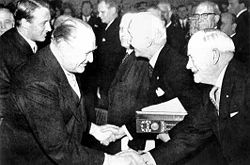
(Picture from: www.redcross.int)
In 1952, the 1928 common statute of the movement was revised for the first time. Also, the period of decolonization from 1960 to 1970 was marked by a huge jump in the number of recognized national Red Cross and Red Crescent societies. By the end of the 1960's, there were more than 100 societies around the world. On December 10, 1963, the Federation and the ICRC received the Nobel Peace Prize. In 1983, the League was renamed to the "League of Red Cross and Red Crescent Societies" to reflect the growing number of national societies operating under the Red Crescent symbol. Three years later, the seven basic principles of the movement as adopted in 1965 were incorporated into its statutes. The name of the League was changed again in 1991, to its current official designation the "International Federation of Red Cross and Red Crescent Societies." In 1997, the ICRC and the Federation signed the Seville Agreement which further defined the responsibilities of both organizations within the movement. In 2004, the Federation began its largest mission to date after the tsunami disaster in South Asia. More than 40 national societies have worked with more than 22,000 volunteers to bring relief to the countless victims left without food and shelter and endangered by the risk of epidemics.
Activities
Organization of the movement
Altogether, there are about 97 million people worldwide who serve with the ICRC, the International Federation, and the National Societies. And there are about 300,000 total full time staff members.
The 1965 International Conference in Vienna adopted seven basic principles which should be shared by all parts of the Movement, and they were added to the official statutes of the Movement in 1986.
- Humanity
- Impartiality
- Neutrality
- Independence
- Voluntary Service
- Unity
- Universality
The International Red Cross and Red Crescent Conference, which occurs once every four years, is the highest institutional body of the Movement. It gathers delegations from all of the national societies as well as from the ICRC, the Federation and the signatory states to the Geneva Conventions. In between the conferences, the Standing Commission acts as the supreme body and supervises implementation of and compliance with the resolutions of the conference. In addition, the Standing Commission coordinates the cooperation between the ICRC and the Federation. It consists of two representatives from the ICRC (including its president), two from the Federation (including its president), and five individuals who are elected by the International Conference. The Standing Commission convenes every six months on average. Moreover, a convention of the Council of Delegates of the Movement takes place every two years in the course of the conferences of the General Assemblies of the Federation. The Council of Delegates plans and coordinates joint activities for the Movement.
Activities and organization of the ICRC
The mission of the ICRC and its responsibilities within the movement
The official mission of the ICRC as an impartial, neutral, and independent organization is to stand for the protection of the life and dignity of victims of international and internal armed conflicts. According to the 1997 Seville Agreement, it is the "Lead Agency" of the Movement in conflicts. The core tasks of the Committee, which are derived from the Geneva Conventions and its own statutes, are the following:
- To monitor compliance of warring parties with the Geneva Conventions
- To organize nursing and care for those who are wounded on the battlefield
- To supervise the treatment of prisoners of war
- To help with the search for missing persons in an armed conflict (tracing service)
- To organize protection and care for civil populations
- To arbitrate between warring parties in an armed conflict
Legal status and organization
The ICRC is headquartered in the Swiss city of Geneva and has external offices in about 80 countries. It has about 12,000 staff members worldwide, about 800 of them working in its Geneva headquarters, 1,200 expatriates with about half of them serving as delegates managing its international missions and the other half being specialists like doctors, agronomists, engineers or interpreters, and about 10,000 members of individual national societies working on site. Contrary to popular belief, the ICRC is not a non-governmental organization in the most common sense of the term, nor is it an international organization. As it limits its members (a process called cooptation) to Swiss nationals only, it does not have a policy of open and unrestricted membership for individuals like other legally defined NGOs. The word "international" in its name does not refer to its membership but to the worldwide scope of its activities as defined by the Geneva Conventions. The ICRC has special privileges and legal immunities in many countries, based on national law in these countries or through agreements between the Committee and respective national governments. According to Swiss law, the ICRC is defined as a private association. According to its statutes it consists of 15 to 25 Swiss-citizen members, which it coopts for a period of four years. There is no limit to the number of terms an individual member can have although a three-quarters majority of all members is required for re-election after the third term.
The leading organs of the ICRC are the Directorate and the Assembly. The Directorate is the executive body of the Committee. It consists of a General Director and five directors in the areas of "Operations," "Human Resources," "Resources and Operational Support," "Communication," and "International Law and Cooperation within the Movement." The members of the Directorate are appointed by the Assembly to serve for four years. The Assembly, consisting of all of the members of the Committee, convenes on a regular basis and is responsible for defining aims, guidelines, and strategies and for supervising the financial matters of the Committee. The president of the Assembly is also the president of the Committee as a whole. Furthermore, the Assembly elects a five member Assembly Council which has the authority to decide on behalf of the full Assembly in some matters. The Council is also responsible for organizing the Assembly meetings and for facilitating communication between the Assembly and the Directorate.
Due to Geneva's location in the French-speaking part of Switzerland, the ICRC usually acts under its French name Comité international de la Croix-Rouge (CICR). The official symbol of the ICRC is the Red Cross on white background with the words "COMITE INTERNATIONAL GENEVE" circling the cross.
Funding and financial matters
The 2005 budget of the ICRC amounts to about 970 million Swiss Francs. Most of that money comes from Switzerland in its capacity as the depositary state of the Geneva Conventions, from national Red Cross societies, the signatory states of the Geneva Conventions, and from international organizations like the European Union. All payments to the ICRC are voluntary and are received as donations based on two types of appeals issued by the Committee: An annual Headquarters Appeal to cover its internal costs and Emergency Appeals for its individual missions. The total budget for 2005 consists of about 819.7 million Swiss Francs (85 percent of the total) for field work and 152.1 million Swiss Francs (15%) for internal costs. In 2005, the budget for field work increased by 8.6 percent and the internal budget by 1.5 percent compared to 2004, primarily due to above average increases in the number and scope of its missions in Africa.
Activities and organization of the federation
The mission of the federation and its responsibilities within the movement
The Federation coordinates cooperation between national Red Cross and Red Crescent societies throughout the world and supports the foundation of new national societies in countries where no official society exists. On the international stage, the Federation organizes and leads relief assistance missions after emergencies like natural disasters, man-made disasters, epidemics, mass refugee flights, and other emergencies. According to the 1997 Seville Agreement, the Federation is the Lead Agency of the Movement in any emergency situation which does not take place as part of an armed conflict. The Federation cooperates with the national societies of those countries affectedâeach called the Operating National Society (ONS)âas well as the national societies of other countries willing to offer assistanceâcalled Participating National Societies (PNS). Among the 187 national societies admitted to the General Assembly of the Federation as full members or observers, about 25-30 regularly work as PNS in other countries. The most active of those are the American Red Cross, the British Red Cross, the German Red Cross, and the Red Cross societies of Sweden and Norway. Another major mission of the Federation which has gained attention in recent years is its commitment to work towards a codified, worldwide ban on the use of land mines and to bring medical, psychological, and social support for people injured by land mines.
The tasks of the Federation can therefore be summarized as follows:
- To promote humanitarian principles and values
- To provide relief assistance in emergency situations of large magnitude
- To support the national societies with disaster preparedness through the education of voluntary members and the provision of equipment and relief supplies
- To support local health care projects
- To support the national societies with youth-related activities
Legal status and organization
Like the ICRC, the Federation has its headquarters in Geneva. It also runs 14 permanent regional offices and has about 350 delegates in more than 60 delegations around the world. The legal basis for the work of the Federation is its constitution. The executive body of the Federation is a secretariat, led by a Secretary General. The secretariat is supported by four divisions labeled "Support Services," "National Society and Field Support," "Policy and Relations" and "Movement Cooperation." The Movement Cooperation division organizes interaction and cooperation with the ICRC. The highest body of the Federation is the General Assembly which convenes every two years with delegates from all of the national societies. Among other tasks, the General Assembly elects the Secretary General. Between the convening of General Assemblies, the Governing Board is the leading body of the Federation. It has the authority to make decisions for the Federation in a number of areas. The Governing Board consists of the president and the vice presidents of the Federation, the chairman of the Finance Commission, and twenty elected representatives from national societies. It is supported by four additional commissions: "Disaster Relief," "Youth," "Health & Community Services," and "Development."
The symbol of the Federation is the combination of the Red Cross (left) and Red Crescent (right) on a white background (surrounded by a red rectangular frame) without any additional text.
Funding and financial matters
The main parts of the budget of the Federation are funded by contributions from the national societies which are members of the Federation and through revenues from its investments. The exact amount of contributions from each member society is established by the Finance Commission and approved by the General Assembly. Any additional funding, especially for unforeseen expenses for relief assistance missions, is raised by appeals published by the Federation and comes from voluntary donations by national societies, governments, other organizations, corporations, and individuals.
National societies within the movement
Official Recognition of a national society
National Red Cross and Red Crescent societies exist in nearly every country in the world. Within their home country, they take on the duties and responsibilities of a national relief society as defined by International Humanitarian Law. Within the Movement, the ICRC is responsible for legally recognizing a relief society as an official national Red Cross or Red Crescent society. The exact rules for recognition are defined in the statutes of the Movement. Article 4 of these statutes contains the "Conditions for recognition of National Societies:"
- In order to be recognized in terms of Article 5, paragraph 2 b) as a National Society, the Society shall meet the following conditions:
- Be constituted on the territory of an independent State where the Geneva Convention for the Amelioration of the Condition of the Wounded and Sick in Armed Forces in the Field is in force.
- Be the only National Red Cross or Red Crescent Society of the said State and be directed by a central body which shall alone be competent to represent it in its dealings with other components of the Movement.
- Be duly recognized by the legal government of its country on the basis of the Geneva Conventions and of the national legislation as a voluntary aid society, auxiliary to the public authorities in the humanitarian field.
- Have an autonomous status which allows it to operate in conformity with the Fundamental Principles of the Movement.
- Use the name and emblem of the Red Cross or Red Crescent in conformity with the Geneva Conventions.
- Be so organized as to be able to fulfill the tasks defined in its own statutes, including the preparation in peace time for its statutory tasks in case of armed conflict.
- Extend its activities to the entire territory of the State.
- Recruit its voluntary members and its staff without consideration of race, sex, class, religion or political opinions.
- Adhere to the present Statutes, share in the fellowship which unites the components of the Movement and co-operate with them.
- Respect the Fundamental Principles of the Movement and be guided in its work by the principles of international humanitarian law.
After recognition by the ICRC, a national society is admitted as a member to the International Federation of Red Cross and Red Crescent societies.
Activities of national societies on a national and international stage
Despite formal independence regarding its organizational structure and work, each national society is still bound by the laws of its home country. In many countries, national Red Cross and Red Crescent societies enjoy exceptional privileges due to agreements with their governments or specific "Red Cross Laws" granting full independence as required by the International Movement. The duties and responsibilities of a national society as defined by International Humanitarian Law and the statutes of the Movement include humanitarian aid in armed conflicts and emergency crises such as natural disasters. Depending on their respective human, technical, financial, and organizational resources, many national societies take on additional humanitarian tasks within their home countries such as Blood donation services or acting as civilian Emergency Medical Service (EMS) providers. The ICRC and the International Federation cooperate with the national societies in their international missions, especially with human, material, and financial resources and organizing on-site logistics.
Symbols of the movement
Protection symbols vs. organizational emblems
The symbols described below have two distinctively different meanings. On one hand, the visual symbols of the Red Cross, the Red Crescent, the Red Lion with Sun and the Red Crystal serve as protection markings in armed conflicts, a denotation which is derived from and defined in the Geneva Conventions. This is called the protective use of the symbols. On the other hand, these symbols are used as distinctive logos by those organizations which are part of the International Red Cross and Red Crescent Movement. This is the indicative use of the emblems, a meaning which is defined in the statutes of the International Movement and partly in the third Additional Protocol.
As a protection symbol, they are used in armed conflicts to mark persons and objects (buildings, vehicles, and so on) which are working in compliance with the rules of the Geneva Conventions. In this function, they can also be used by organizations and objects which are not part of the International Red Cross and Red Crescent Movement, for example the medical services of the armed forces, civilian hospitals, and civil defense units. As protection symbols, these emblems should be used without any additional specification (textual or otherwise) and in a prominent manner which makes them as visible and observable as possible, for example by using large white flags bearing the symbol. Four of these symbols, namely the Red Cross, the Red Crescent, the Red Lion with Sun, and the Red Crystal, are defined in the Geneva Conventions and their Additional Protocols as symbols for protective use.
When used as an organizational logo, these symbols only indicate that persons, vehicles, buildings, etc. which bear the symbols belong to a specific organization which is part of the International Red Cross and Red Crescent Movement (like the ICRC, the International Federation or the national Red Cross and Red Crescent societies). In this case, they should be used with an additional specification (for example "American Red Cross") and not be displayed as prominently as when used as protection symbols. Three of these symbols, namely the Red Cross, the Red Crescent and the Red Crystal, can be used for indicative purposes by national societies for use in their home country or abroad. In addition to that, the Red Shield of David can be used by the Israel society Magen David Adom for indicative purposes within Israel, and, pending the approval of the respective host country, in combination with the Red Crystal when working abroad.
Red Cross
The Red Cross on white background was the original protection symbol declared at the 1864 Geneva Convention. It is, in terms of its color, a reversal of the Swiss national flag, a meaning which was adopted to honor Swiss founder Henry Dunant and his home country. The ideas to introduce a uniform and neutral protection symbol as well as its specific design originally came from Dr. Louis Appia and General Henri Dufour, founding members of the International Committee. The Red Cross is defined as a protection symbol in Article 7 of the 1864 Geneva Convention, Chapter VII ("The distinctive emblem") and Article 38 of the 1949 Geneva Convention ("For the Amelioration of the Condition of the Wounded and Sick in Armed Forces in the Field"). There is an unofficial agreement within the Red Cross and Red Crescent Movement that the shape of the cross should be a cross composed of five squares. However, regardless of the shape, any Red Cross on white background should be valid and must be recognized as a protection symbol in conflict. Of the 186 national societies which are currently recognized by the ICRC, 152 are using the Red Cross as their official organization emblem. In addition, the Red Cross is currently used by the national society of Tuvalu which has applied for official recognition.
Red Crescent
During the Russo-Turkish War from 1876 to 1878, the Ottoman Empire used a Red Crescent instead of the Red Cross because its government believed that the cross would alienate its Muslim soldiers. When asked by the ICRC in 1877, Russia committed to fully respect the sanctity of all persons and facilities bearing the Red Crescent symbol, followed by a similar commitment from the Ottoman government to respect the Red Cross. After this de facto assessment of equal validity to both symbols, the ICRC declared in 1878 that it should be possible in principle to adopt an additional official protection symbol for non-Christian countries. The Red Crescent was formally recognized in 1929 when the Geneva Conventions were amended (Article 19).[1] Originally, the Red Crescent was used by Turkey and Egypt. From its official recognition to today, the Red Crescent became the organizational emblem of nearly every national society in countries with majority Muslim populations. The national societies of some countries such as Pakistan (1974), Malaysia (1975), or Bangladesh (1989) have officially changed their name and emblem from the Red Cross to the Red Crescent. The Red Crescent is used by 33 of the 186 recognized societies worldwide.
Red Crystal
Because of the controversy over Israel's national society Magen David Adom and a number of other disputes, the introduction of an additional neutral protection symbol had been under discussion for a number of years, with the Red Crystal (previously referred to as the Red Lozenge or Red Diamond) being the most popular proposal. Other attempts have included Sri Lanka (1957) and India (1977) who tried to establish a Red Swastika and also efforts by the national societies of Kazakhstan and Eritrea to use a unique combination of the Red Cross and the Red Crescent, similar to the combination of both symbols used by the national society of the Soviet Union until its demise. However, amending the Geneva Conventions to add a new protection symbol requires a diplomatic conference of all 192 signatory states to the Conventions. The Swiss government organized such a conference to take place on December 5-6, 2005, to adopt a third additional protocol to the Geneva Conventions introducing the Red Crystal as an additional symbol with equal status to the Red Cross or Red Crescent. Following an unplanned extension of the conference until December 7, the protocol was adopted after a vote successfully achieved the required two-thirds majority. From the countries which attended the conference, 98 voted in favor and 27 against the protocol, while 10 countries abstained from voting.
In the third Protocol the new symbol is referred to as "the third Protocol emblem." The rules for the use of this symbol, based on the third additional protocol to the Geneva Conventions, are the following:
- Within its own national territory, a national society can use either of the recognized symbols alone, or incorporate any of these symbols or a combination of them into the Red Crystal. Furthermore, a national society can choose to display a previously and effectively used symbol, after officially communicating this symbol to the state parties of the Geneva Conventions through Switzerland as the depositary state prior to the adoption of the proposed third additional protocol.
- For indicative use on foreign territory, a national society which does not use one of the recognized symbols as its emblem has to incorporate its unique symbol into the Red Crystal, based on the previously mentioned condition about communicating its unique symbol to the state parties of the Geneva Conventions.
- For protective use, only the symbols recognized by the Geneva Conventions can be used. Specifically, those national societies which do not use one of the recognized symbols as their emblem have to use the Red Crystal without incorporation of any additional symbol.
On June 22, 2006, the ICRC announced that the International Red Cross and Red Crescent Movement adopted the Red Crystal as additional emblem for use by the national societies. The ICRC also announced the recognition of the Palestine Red Crescent Society (PRCS) and the Israeli National Society, Magen David Adom (MDA). On January 14, 2007, the third additional protocol entered into force.
Red Lion with Sun
From 1924 to 1980, Iran used a "Red Lion with Sun" symbol for its national society, based on the flag and emblem of the Qajar Dynasty. The Red Lion with Sun was formally recognized as a protection symbol in 1929, together with the Red Crescent. Despite the country's shift to the Red Crescent in 1980, Iran explicitly maintains the right to use the symbol. Therefore, it is still recognized by the Geneva Convention as a protection symbol with equal status to the Red Cross, Red Crescent and Red Crystal.
Red Shield of David
Magen David Adom, the national society of Israel, has used the Red Shield of David as its organization emblem since its foundation. The Red Shield of David was initially proposed as an addition to the Red Cross, Red Crescent, and Red Lion with Sun in 1931. The proposal was rejected by the ICRC, like the Mehrab-e-Ahmar (Red Archway) symbol of the national aid society of Afghanistan four years later, as well as a wide range of other proposals, due to concerns about symbol proliferation.[2] Israel again tried to establish the emblem as a third protection symbol in the context of the Geneva Conventions, but a respective proposal was narrowly defeated when the Geneva Conventions were adopted by governments in 1949. As the Red Shield of David is not a recognized protection symbol under the Geneva Conventions, Magen David Adom's recognition as a national society by the ICRC was long delayed.
It was not until 2006 that the ICRC officially recognized Magen David Adom.[3] The adoption of the third protocol emblem paved the way for the recognition and admission of Magen David Adom as a full member of the International Federation, as the rules of the third protocol allow it to continue using the Red Shield of David when operating within Israel and provide a solution for its missions abroad. Though the organization only recently gained official recognition, it has had an excellent reputation within the Movement for many years and took part in many international activities, in cooperation with both the ICRC and the Federation, prior to its official recognition.
Mottos of the Movement, Commemoration Day and places of interest
The original motto of the International Committee of the Red Cross was Inter Arma Caritas ("In War, Charity"). This Christian-spirited slogan was amended in 1961 with the neutral motto Per Humanitatem ad Pacem or "With humanity, towards peace." While Inter Arma Caritas is still the primary motto of the ICRC (as per Article 3 of the ICRC statutes), Per Humanitatem ad Pacem is the primary motto of the Federation (Article 1 of the Constitution of the Federation). Both organizations acknowledge the alternative motto, and together both slogans serve as the combined motto of the International Movement.
The mission statement of the International Movement as formulated in the "Strategy 2010" document of the Federation is to improve the lives of vulnerable people by mobilizing the power of humanity. From 1999 to 2004, the common slogan for all activities of the International Movement was The Power of Humanity. In December 2003, the 28th International Conference in Geneva adopted the conference motto Protecting Human Dignity as the new Movement slogan.
The 16th International Conference which convened in London in 1938 officially decided to make May 8, the birthday of Henry Dunant, as the official annual commemoration and celebration day of the Movement. Since 1984, the official name of the celebration day has been "World Red Cross and Red Crescent Day."
In Solferino, a small museum describes the history of the Battle of Solferino and of the Risorgimento, the long and bloody Italian struggle for independence and unity. In the Ossario di Solferino (Solferino Ossuary) in close proximity to the museum, a moving display shows the horrors of war. Inside the chapel, 1,413 skulls and many more bones from thousands of French and Austrian troops who died during the battle are shown. Solferino is also host to the International Red Cross Memorial inaugurated in 1959 on the centennial of the Battle of Solferino. The memorial contains stone plaques identifying each recognized national society. In Castiglione delle Stiviere, a small town near Solferino, the International Museum of the Red Cross was also opened in 1959. Moreover, another museum, the International Red Cross and Red Crescent Museum stands in Geneva in close proximity to the headquarters of the ICRC. Finally, in the Swiss city of Heiden, the Henry Dunant Museum was opened to preserve the memory and legacy of Dunant himself.
Evaluation
Alhough essentially a voluntary organization, the Red Cross has not escaped criticism. Due to its responsibilities under the Geneva Conventions, its status with respect to its Prisoner of War work is more complex. However, much of its work is humanitarian relief and often the Red Cross is the first organization to arrive at a scene of calamity or need. In some instances, it has been the only organization to remain when all other international agencies have withdrawn. This, for example, was the case during the genocide in Rwanda of 1994. Controversy, when it has occured, has usually surrounded how the Red Cross has interpreted the Geneva Conventions. In several instances, its intepretation has been upheld by various courts. For example, the claim that detainees at the United States Guantanomo Bay center were covered by the Convention was upheld by the Supreme Court of the United States which also ruled that the detainees were unlawfully improsoned.[4] While the Red Cross has aided Palestinians in the West Bank and Gaza, it has maintained that as the occupying power, Israel should "should ensure the whole population has access to food and water, medical assistance, employment and education."[5] While Israel's position is that the Geneva Convention does not apply ion the West Bank, the International Court of Justice has ruled that the Convention does apply, which again can be interpreted as a vindication of the stance that the Red Cross has taken.[6]
Notes
- â History of the Emblems, ICRC 14.03.2006 The History of The Emblems. Retrieved December 14, 2007.
- â Seiyaku, The Red Crossâan emblem of the world's largest humanitarian organization. Retrieved December 14, 2007.
- â BBC News June 22, 2006, Red Cross votes to admit Israel. Retrieved December 14, 2007.
- â BBC July 8, 2004, US Supreme Court Guantanomo ruling. Retrieved January 7, 2008.
- â Sharmila Deviin, Red Cross Calls Halt to West Bank Aid. Retrieved January 7, 2008.
- â BBC News August 24, 2004, Consider Geneva pact, Israel told. Retrieved January 7, 2008.
ReferencesISBN links support NWE through referral fees
- Bennett, Angela. 2005. The Geneva Convention the Hidden Origins of the Red Cross. Stroud, Gloucestershire: Sutton. ISBN 9780750941471.
- Boissier, Pierre, Pierre Boissier, André Durand, and Pierre Boissier. 1985. History of the International Committee of the Red Cross. Scientific collection of the Henry Dunant Institute. Geneva: Henry Dunant Institute. ISBN 9782880440121.
- Bugnion, François. 2003. The International Committee of the Red Cross and the Protection of War Victims. Geneva: International Committee of the Red Cross. ISBN 9780333747711.
- Dunant, Henri. 1959. A Memory of Solferino. Red Cross. ISBN 2-88145-006-7.
- Durand, André, and Pierre Boissier. 1984. From Sarajevo to Hiroshima History of the International Committee of the Red Cross. Geneva: Henry Dunant Institute. ISBN 9782880440091.
- Forsythe, David P. 1977. Humanitarian Politics the International Committee of the Red Cross. Baltimore: Johns Hopkins University Press. ISBN 9780801819834.
- Forsythe, David P. 2005. The Humanitarians the International Committee of the Red Cross. Cambridge: Cambridge University Press. ISBN 9780521612814.
- Haug, Hans, Hans-Peter Gasser, Françoise Perret, and Jean-Pierre Robert-Tissot. 1993. Humanity for all the International Red Cross and Red Crescent Movement. Berne: P. Haupt. ISBN 9783258047195.
- Hutchinson, John F. 1996. Champions of Charity: War and the Rise of the Red Cross. Boulder: Westview Press ISBN 9780813331164.
- International Committee of the Red Cross. 1994. Handbook of the International Red Cross and Red Crescent Movement. Geneva: International Committee of the Red Cross. ISBN 9782881450747.
- Moorehead, Caroline. 1999. Dunant's Dream War, Switzerland, and the History of the Red Cross. New York: Carroll & Graf Pub. ISBN 9780786706099.
- Willemin, Georges, Roger Heacock, and Jacques Freymond. 1984. The International Committee of the Red Cross. International Organization and the Evolution of World Society, v. 2. Boston: Martinus Nijhoff., ISBN 9789024730643.
External links
All links retrieved December 7, 2022.
- International Committee of the Red Cross (ICRC)
- International Federation of Red Cross and Red Crescent Societies (IFRC)
| ||||||||
| ||||||||
| |||||
Credits
New World Encyclopedia writers and editors rewrote and completed the Wikipedia article in accordance with New World Encyclopedia standards. This article abides by terms of the Creative Commons CC-by-sa 3.0 License (CC-by-sa), which may be used and disseminated with proper attribution. Credit is due under the terms of this license that can reference both the New World Encyclopedia contributors and the selfless volunteer contributors of the Wikimedia Foundation. To cite this article click here for a list of acceptable citing formats.The history of earlier contributions by wikipedians is accessible to researchers here:
The history of this article since it was imported to New World Encyclopedia:
Note: Some restrictions may apply to use of individual images which are separately licensed.
